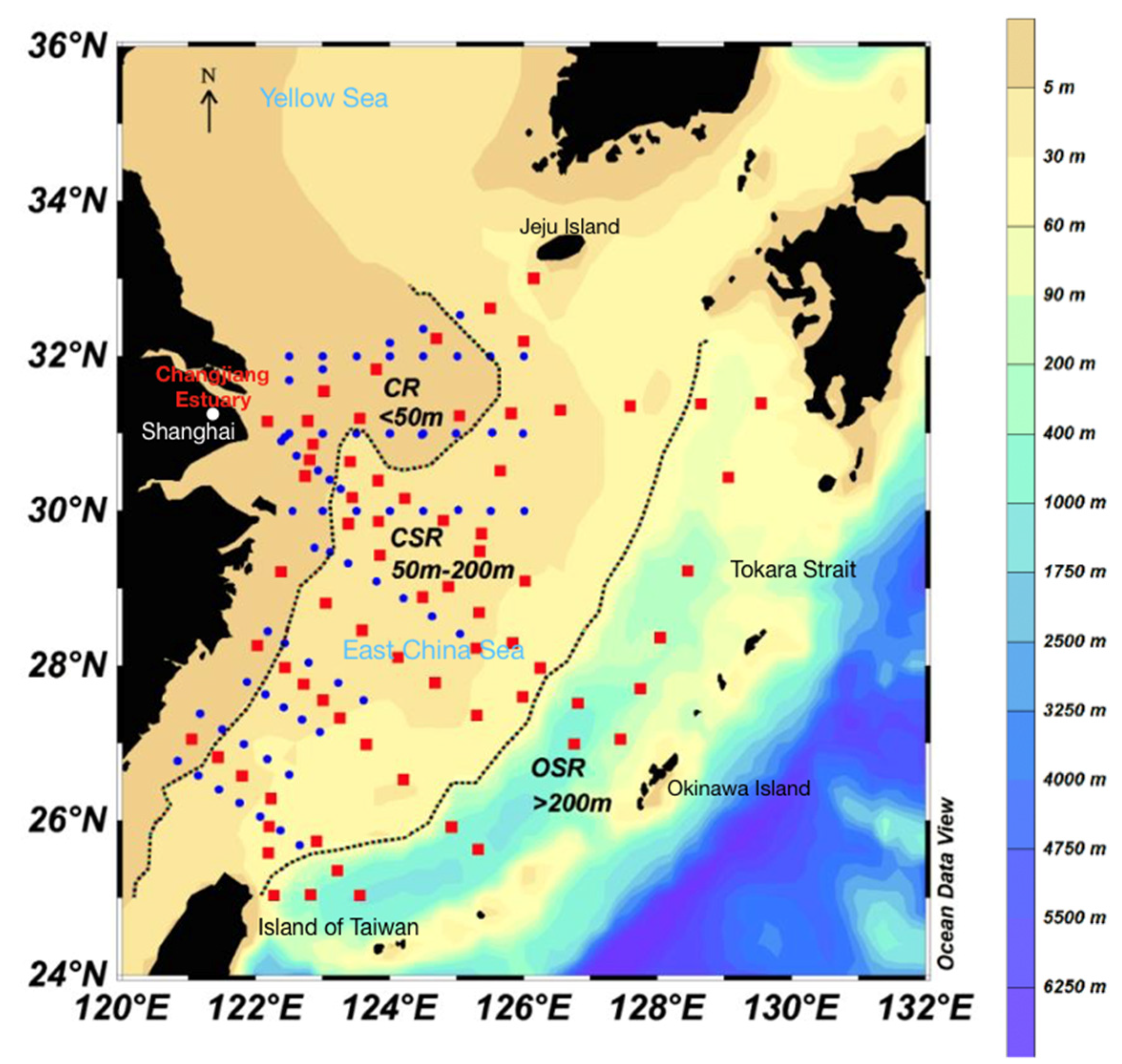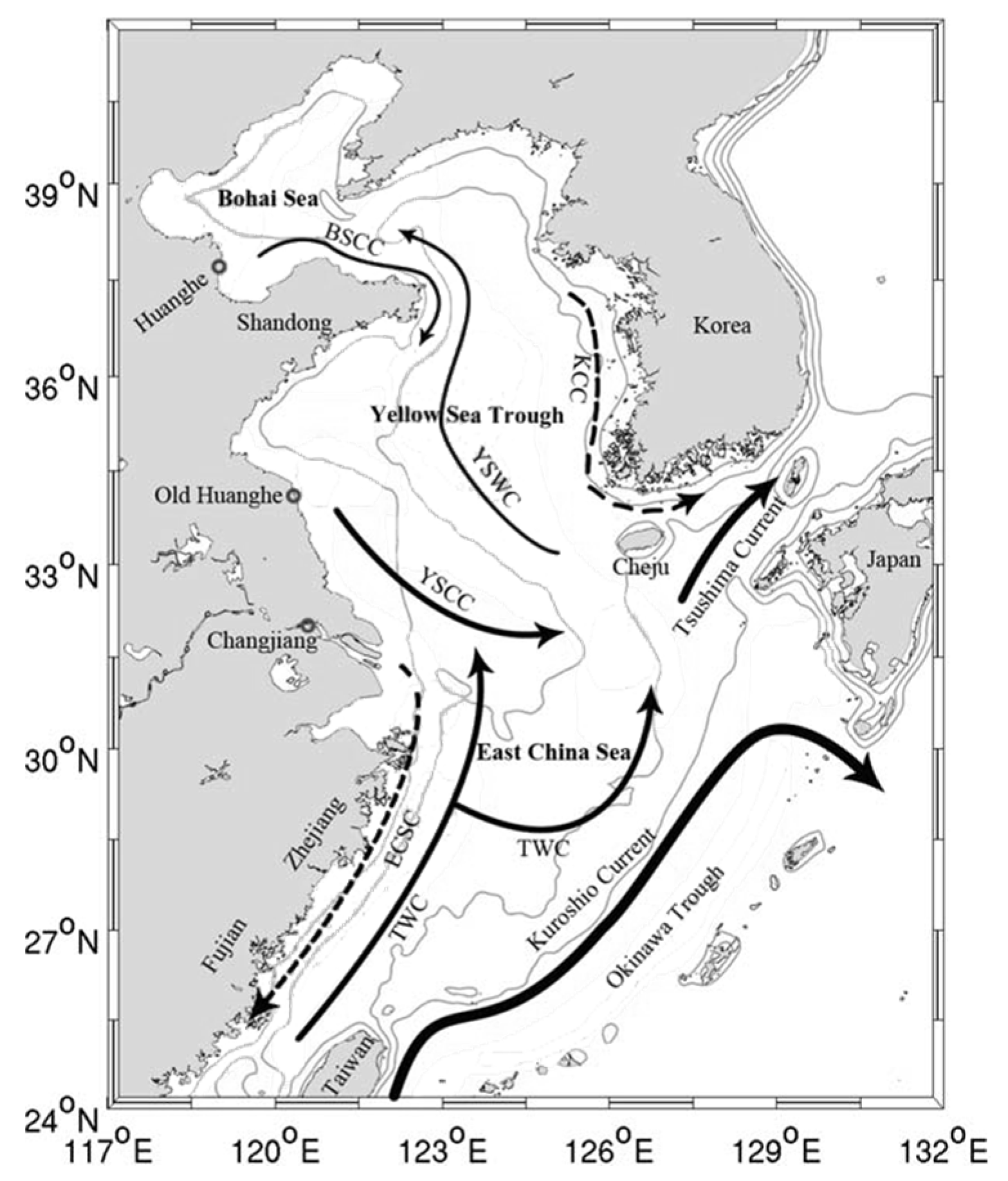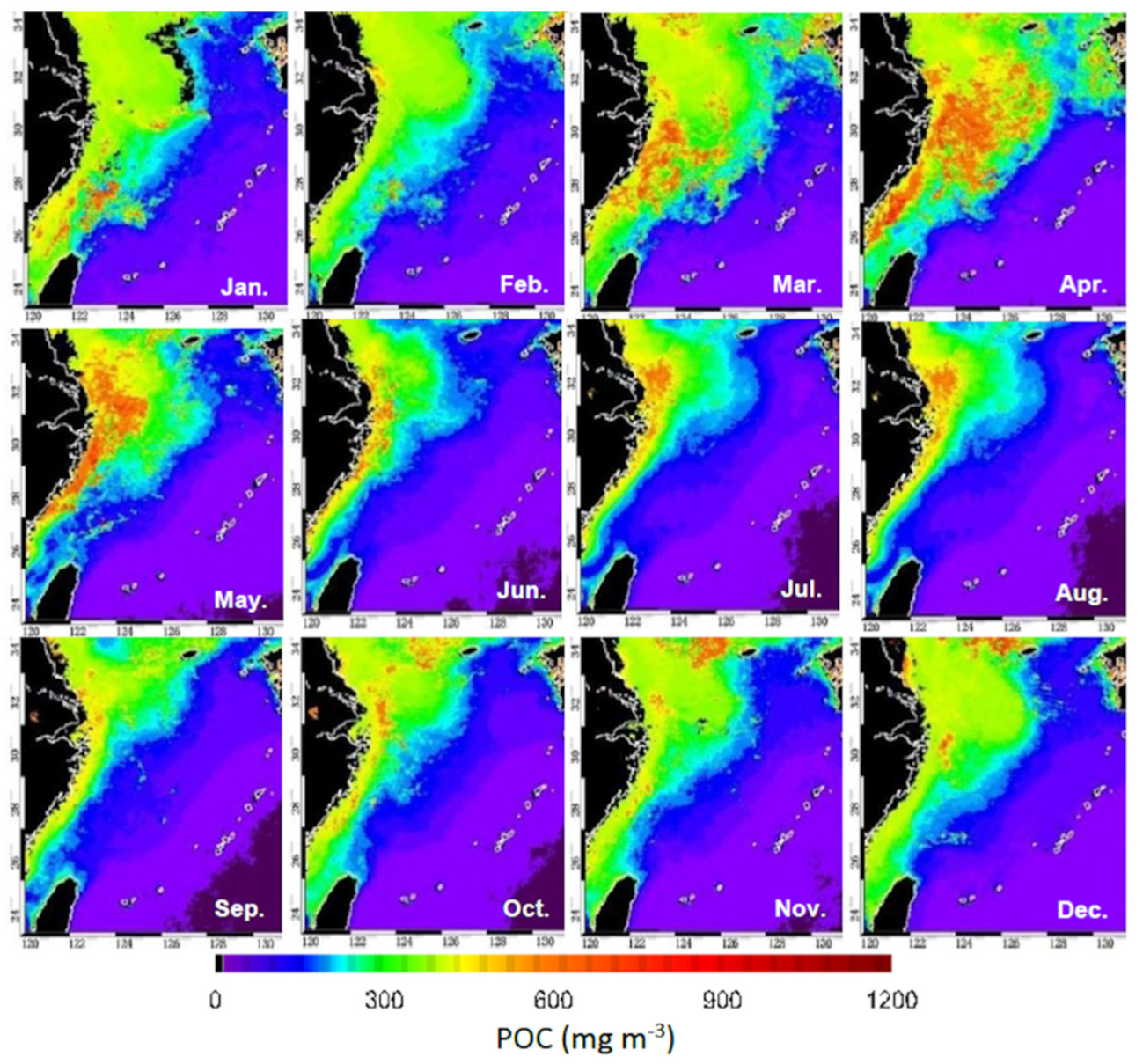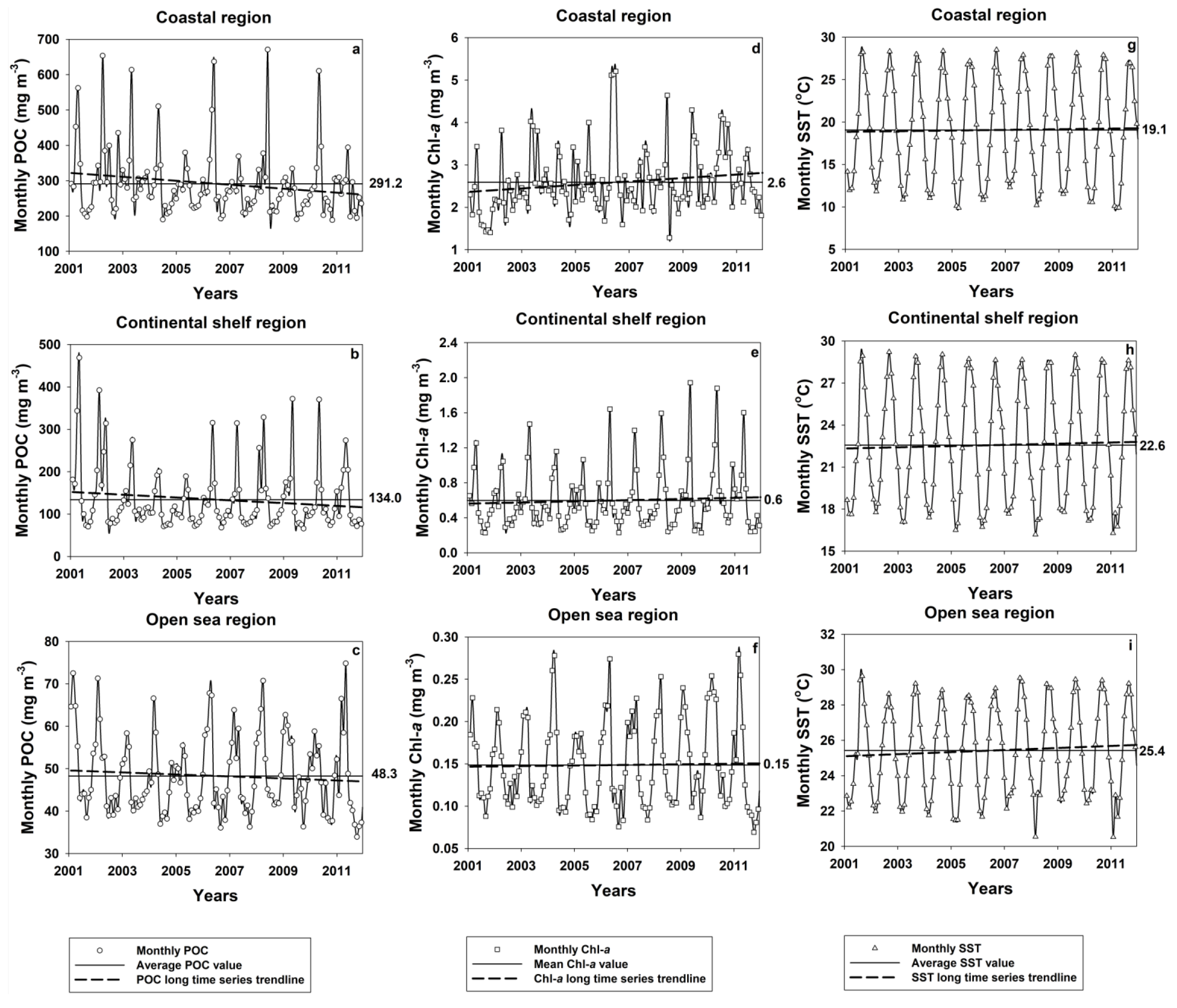Satellite Observed Spatial and Temporal Variabilities of Particulate Organic Carbon in the East China Sea
Abstract
:1. Introduction
2. Materials and Methods
2.1. Study Area
2.2. Data
3. Results and Discussion
3.1. Spatiotemporal Distribution
3.2. Relationship between POC and Chl-a/SST
3.3. Interannual Variabilities of POC in Different Regions of ECS
3.3.1. Coastal Region
3.3.2. Open Sea Region
3.3.3. Continental Shelf Region
3.4. Estimation of Organic Carbon Storage in ECS
4. Summary
Author Contributions
Funding
Data Availability Statement
Acknowledgments
Conflicts of Interest
References
- Jahnke, R.A. The global ocean flux of particulate organic carbon: Areal distribution and magnitude. Glob. Biogeochem. Cycles 1996, 10, 71–88. [Google Scholar] [CrossRef]
- Loisel, H.; Nicolas, J.M.; Deschamps, P.Y.; Frouin, R. Seasonal and inter-annual variability of particulate organic matter in the global ocean. Geophys. Res. Lett. 2002, 29, 49–51. [Google Scholar] [CrossRef]
- Ducklow, H.W.; Steinberg, D.K.; Buesseler, K.O. Upper ocean carbon export and the biological pump. Oceanography 2001, 14, 50–58. [Google Scholar] [CrossRef]
- Honjo, S.; Manganini, S.J.; Krishfield, R.A.; Francois, R. Particulate organic carbon fluxes to the ocean interior and factors controlling the biological pump: A synthesis of global sediment trap programs since 1983. Prog. Oceanogr. 2008, 76, 217–285. [Google Scholar] [CrossRef]
- Honjo, S.; Eglinton, T.I.; Taylor, C.D.; Ulmer, K.M.; Sievert, S.M.; Bracher, A.; German, C.R.; Edgcomb, V.; Francois, R.; Iglesias-Rodriguez, M.D. Understanding the role of the biological pump in the global carbon cycle: An imperative for ocean science. Oceanography 2014, 27, 10–16. [Google Scholar] [CrossRef] [Green Version]
- Thomsen, L.; Aguzzi, J.; Costa, C.; De Leo, F.; Ogston, A.; Purser, A. The oceanic biological pump: Rapid carbon transfer to depth at continental margins during winter. Sci. Rep. 2017, 7, 10763. [Google Scholar]
- Wakeham, S.G.; Lee, C.; Farrington, J.W.; Gagosian, R.B. Biogeochemistry of particulate organic matter in the oceans: Results from sediment trap experiments. Deep Sea Res. Part A Oceanogr. Res. Pap. 1984, 31, 509–528. [Google Scholar] [CrossRef]
- Wakeham, S.G.; Lee, C.; Hedges, J.I. Fluxes of major biochemicals in the equatorial Pacific Ocean. In Dynamics and Characterization of Marine Organic Matter; Handa, N., Tanoue, E., Hama, T., Eds.; Terra Scientific Publishing Company: Tokyo, Japan/Kluwer, Dordrecht, 2000; pp. 117–140. [Google Scholar]
- Wang, S.-L.; Chen, C.-T.A.; Hong, G.-H.; Chung, C.-S. Carbon dioxide and related parameters in the East China Sea. Cont. Shelf Res. 2000, 20, 525–544. [Google Scholar] [CrossRef]
- Gong, G.C.; Chang, J.; Chiang, K.P.; Hsiung, T.M.; Hung, C.C.; Duan, S.W.; Codispoti, L. Reduction of primary production and changing of nutrient ratio in the East China Sea: Effect of the Three Gorges Dam? Geophys. Res. Lett. 2006, 33. [Google Scholar] [CrossRef] [Green Version]
- Yang, D.; Yin, B.; Liu, Z.; Feng, X. Numerical study of the ocean circulation on the East China Sea shelf and a Kuroshio bottom branch northeast of Taiwan in summer. J. Geophys. Res. Ocean. 2011, 116. [Google Scholar] [CrossRef] [Green Version]
- Lee, K.; Matsuno, T.; Endoh, T.; Ishizaka, J.; Zhu, Y.; Takeda, S.; Sukigara, C. A role of vertical mixing on nutrient supply into the subsurface chlorophyll maximum in the shelf region of the East China Sea. Cont. Shelf Res. 2017, 143, 139–150. [Google Scholar] [CrossRef]
- Gong, G.-C.; Chen, Y.-L.L.; Liu, K.-K. Chemical hydrography and chlorophyll a distribution in the East China Sea in summer: Implications in nutrient dynamics. Cont. Shelf Res. 1996, 16, 1561–1590. [Google Scholar] [CrossRef]
- Guo, X.; Zhu, X.H.; Wu, Q.S.; Huang, D. The Kuroshio nutrient stream and its temporal variation in the East China Sea. J. Geophys. Res. Ocean. 2012, 117. [Google Scholar] [CrossRef] [Green Version]
- Ziqiang, H.; Tianbao, F.; Yuanhui, Z. Distributive characteristics of POC in sea water in East China Sea. J. Oceanogr. Taiwan Strait 1997, 2, 145–152. [Google Scholar]
- Zhu, Z.Y.; Zhang, J.; Wu, Y.; Lin, J. Bulk particulate organic carbon in the East China Sea: Tidal influence and bottom transport. Prog. Oceanogr. 2006, 69, 37–60. [Google Scholar] [CrossRef]
- Chen, C.T.A.; Wang, S.L. Carbon, alkalinity and nutrient budgets on the East China Sea continental shelf. J. Geophys. Res. Ocean. 1999, 104, 20675–20686. [Google Scholar] [CrossRef]
- Hung, J.-J.; Lin, P.-L.; Liu, K.-K. Dissolved and particulate organic carbon in the southern East China Sea. Cont. Shelf Res. 2000, 20, 545–569. [Google Scholar] [CrossRef]
- Hung, C.C.; Gong, G.C. Export flux of POC in the main stream of the Kuroshio. Geophys. Res. Lett. 2007, 34. [Google Scholar] [CrossRef]
- Hung, C.-C.; Tseng, C.-W.; Gong, G.-C.; Chen, K.-S.; Chen, M.-H.; Hsu, S.-C. Fluxes of particulate organic carbon in the East China Sea in summer. Biogeosciences 2013, 10, 6469–6484. [Google Scholar] [CrossRef] [Green Version]
- Kao, S.; Lin, F.; Liu, K. Organic carbon and nitrogen contents and their isotopic compositions in surficial sediments from the East China Sea shelf and the southern Okinawa Trough. Deep Sea Res. Part II Top. Stud. Oceanogr. 2003, 50, 1203–1217. [Google Scholar] [CrossRef]
- Deng, B.; Zhang, J.; Wu, Y. Recent sediment accumulation and carbon burial in the East China Sea. Glob. Biogeochem. Cycles 2006, 20. [Google Scholar] [CrossRef]
- Stramski, D.; Reynolds, R.A.; Babin, M.; Kaczmarek, S.; Lewis, M.R.; Röttgers, R.; Sciandra, A.; Stramska, M.; Twardowski, M.; Franz, B. Relationships between the surface concentration of particulate organic carbon and optical properties in the eastern South Pacific and eastern Atlantic Oceans. Biogeosciences 2008, 5, 171–201. [Google Scholar] [CrossRef] [Green Version]
- Son, S.; Wang, M. Water properties in Chesapeake Bay from MODIS-Aqua measurements. Remote Sens. Environ. 2012, 123, 163–174. [Google Scholar] [CrossRef] [Green Version]
- Bai, Y.; He, X.; Pan, D.; Hao, Z.; Song, Q.; Lei, H. Remote sensing algorithm of particle attenuation coefficient in East China Sea. In Proceedings of the Remote Sensing of the Ocean, Sea Ice, and Large Water Regions 2008, Cardiff, Wales, UK, 15–18 September 2008; pp. 241–251. [Google Scholar]
- Liu, Q. Methods for the Estimation of Organic Carbon Stocks in the Upper Layer of the East China Sea by Satellite Remote Sensing. Ph.D. Thesis, Wuhan University, Wuhan, China, 2013. [Google Scholar]
- Fan, H.; Wang, X.; Zhang, H.; Yu, Z. Spatial and temporal variations of particulate organic carbon in the Yellow-Bohai Sea over 2002–2016. Sci. Rep. 2018, 8, 7971. [Google Scholar]
- Yu, J.; Wang, X.; Murtugudde, R.; Tian, F.; Zhang, R.H. Interannual-to-Decadal Variations of Particulate Organic Carbon and the Contribution of Phytoplankton in the Tropical Pacific During 1981–2016: A Model Study. J. Geophys. Res. Ocean. 2021, 126, e2020JC016515. [Google Scholar] [CrossRef]
- Nelson, D.; Sommers, L.E. Total carbon, organic carbon, and organic matter. Methods Soil Anal. Part 2 Chem. Microbiol. Prop. 1982, 9, 539–579. [Google Scholar]
- Nakatsuka, T.; Toda, M.; Kawamura, K.; Wakatsuchi, M. Dissolved and particulate organic carbon in the Sea of Okhotsk: Transport from continental shelf to ocean interior. J. Geophys. Res. Ocean. 2004, 109. [Google Scholar] [CrossRef] [Green Version]
- Hsueh, Y. The Kuroshio in the East China Sea. J. Mar. Syst. 2000, 24, 131–139. [Google Scholar] [CrossRef]
- Chen, Y.-l.L.; Chen, H.-Y.; Lin, Y.-H. Distribution and downward flux of Trichodesmium in the South China Sea as influenced by the transport from the Kuroshio Current. Mar. Ecol. Prog. Ser. 2003, 259, 47–57. [Google Scholar] [CrossRef]
- Taguchi, B.; Nakamura, H.; Nonaka, M.; Xie, S.-P. Influences of the Kuroshio/Oyashio Extensions on air–sea heat exchanges and storm-track activity as revealed in regional atmospheric model simulations for the 2003/04 cold season. J. Clim. 2009, 22, 6536–6560. [Google Scholar] [CrossRef] [Green Version]
- Zhang, J.; Liu, S.; Ren, J.; Wu, Y.; Zhang, G. Nutrient gradients from the eutrophic Changjiang (Yangtze River) Estuary to the oligotrophic Kuroshio waters and re-evaluation of budgets for the East China Sea Shelf. Prog. Oceanogr. 2007, 74, 449–478. [Google Scholar] [CrossRef]
- Wang, H.; Dai, M.; Liu, J.; Kao, S.-J.; Zhang, C.; Cai, W.-J.; Wang, G.; Qian, W.; Zhao, M.; Sun, Z. Eutrophication-driven hypoxia in the East China Sea off the Changjiang Estuary. Environ. Sci. Technol. 2016, 50, 2255–2263. [Google Scholar] [CrossRef] [PubMed]
- Bian, C.; Jiang, W.; Greatbatch, R.J. An exploratory model study of sediment transport sources and deposits in the Bohai Sea, Yellow Sea, and East China Sea. J. Geophys. Res. Ocean. 2013, 118, 5908–5923. [Google Scholar] [CrossRef] [Green Version]
- Li, N. Distribution, source of organic carbon and carbon-nitrogen-phosphors interaction in Changjing River estuary and Jiaozhou Bay waters. Ph.D. Thesis, The University of the Chinese Academy of Sciences, Beijing, China, 8 June 2006. [Google Scholar]
- Lin, J. Distributions of Dissolved Organic Carbon and Particulate Organic Carbon in the Changjiang Estuary and Its Adjacent Area. Master’s Thesis, East China Normal University, Shanghai, China, 2007. [Google Scholar]
- Cheng, J.; Shi, X.-Y.; Zhang, C.-S.; Wang, L.-S.; Huang, S.; Liu, D.-S. Temporal and spatial distribution of particulate organic carbon in the Yellow Sea and East China Sea in spring. Huan Jing Ke Xue Huanjing Kexue 2011, 32, 2505–2511. [Google Scholar]
- Shi, X.; Zhang, T.; Zhang, C.; Cheng, J. Spatial and temporal distribution of particulate organic carbon in Yellow Sea and East China Sea. Mar. Environ. Sci. 2011, 1, 1–9. [Google Scholar]
- Chen, D.; He, L.; Liu, F.; Yin, K. Effects of typhoon events on chlorophyll and carbon fixation in different regions of the East China Sea. Estuar. Coast. Shelf Sci. 2017, 194, 229–239. [Google Scholar] [CrossRef]
- Chang, P.H.; Isobe, A. A numerical study on the Changjiang diluted water in the Yellow and East China Seas. J. Geophys. Res. Ocean. 2003, 108. [Google Scholar] [CrossRef]
- Kim, H.-C.; Yamaguchi, H.; Yoo, S.; Zhu, J.; Okamura, K.; Kiyomoto, Y.; Tanaka, K.; Kim, S.-W.; Park, T.; Oh, I.S. Distribution of Changjiang diluted water detected by satellite chlorophyll-a and its interannual variation during 1998–2007. J. Oceanogr. 2009, 65, 129–135. [Google Scholar] [CrossRef]
- Ni, X.; Huang, D.; Zeng, D.; Zhang, T.; Li, H.; Chen, J. The impact of wind mixing on the variation of bottom dissolved oxygen off the Changjiang Estuary during summer. J. Mar. Syst. 2016, 154, 122–130. [Google Scholar] [CrossRef] [Green Version]
- Liu, Q.; Kandasamy, S.; Wang, H.; Wang, L.; Lin, B.; Gao, A.; Chen, C.T.A. Impact of hydrological conditions on the biogeochemical dynamics of suspended particulate organic matter in the upper mixed layer of the Southern East China Sea. J. Geophys. Res. Ocean. 2019, 124, 6120–6140. [Google Scholar] [CrossRef]
- Chen, Y.-L.L.; Chen, H.-Y. Nitrate-based new production and its relationship to primary production and chemical hydrography in spring and fall in the East China Sea. Deep Sea Res. Part II Top. Stud. Oceanogr. 2003, 50, 1249–1264. [Google Scholar] [CrossRef]
- Sathyendranath, S.; Stuart, V.; Nair, A.; Oka, K.; Nakane, T.; Bouman, H.; Forget, M.-H.; Maass, H.; Platt, T. Carbon-to-chlorophyll ratio and growth rate of phytoplankton in the sea. Mar. Ecol. Prog. Ser. 2009, 383, 73–84. [Google Scholar] [CrossRef]
- Jakobsen, H.H.; Markager, S. Carbon-to-chlorophyll ratio for phytoplankton in temperate coastal waters: Seasonal patterns and relationship to nutrients. Limnol. Oceanogr. 2016, 61, 1853–1868. [Google Scholar] [CrossRef]
- Wang, B.; Chen, J.; Jin, H.; Li, H.; Huang, D.; Cai, W.J. Diatom bloom-derived bottom water hypoxia off the Changjiang estuary, with and without typhoon influence. Limnol. Oceanogr. 2017, 62, 1552–1569. [Google Scholar] [CrossRef]
- Qu, B.; Song, J.; Yuan, H.; Li, X.; Li, N. Carbon chemistry in the mainstream of Kuroshio current in eastern Taiwan and its transport of carbon into the east China sea shelf. Sustainability 2018, 10, 791. [Google Scholar] [CrossRef] [Green Version]
- Berelson, W.; Haskell II, W.; Prokopenko, M.; Knapp, A.; Hammond, D.; Rollins, N.; Capone, D. Biogenic particle flux and benthic remineralization in the Eastern Tropical South Pacific. Deep Sea Res. Part I Oceanogr. Res. Pap. 2015, 99, 23–34. [Google Scholar] [CrossRef]
- Kelly, P.; Clementson, L.; Davies, C.; Corney, S.; Swadling, K. Zooplankton responses to increasing sea surface temperatures in the southeastern Australia global marine hotspot. Estuar. Coast. Shelf Sci. 2016, 180, 242–257. [Google Scholar] [CrossRef]
- Cronin, M.F.; Kessler, W.S. Near-surface shear flow in the tropical Pacific cold tongue front. J. Phys. Oceanogr. 2009, 39, 1200–1215. [Google Scholar] [CrossRef] [Green Version]
- Pan, A.; Guo, X.; Xu, J.; Huang, J.; Wan, X. Responses of Guangdong coastal upwelling to the summertime typhoons of 2006. Sci. China Earth Sci. 2012, 55, 495–506. [Google Scholar] [CrossRef]
- China Statistical Yearbook; National Bureau of Statistics of China; China Statistics Press: Beijing, China, 1999–2008.
- Harrison, P.; Hu, M.; Yang, Y.; Lu, X. Phosphate limitation in estuarine and coastal waters of China. J. Exp. Mar. Biol. Ecol. 1990, 140, 79–87. [Google Scholar] [CrossRef]
- Zhou, Z.-X.; Yu, R.-C.; Zhou, M.-J. Resolving the complex relationship between harmful algal blooms and environmental factors in the coastal waters adjacent to the Changjiang River estuary. Harmful Algae 2017, 62, 60–72. [Google Scholar] [CrossRef] [PubMed]
- Wang, B. Cultural eutrophication in the Changjiang (Yangtze River) plume: History and perspective. Estuar. Coast. Shelf Sci. 2006, 69, 471–477. [Google Scholar] [CrossRef]
- Li, Y.; Li, D.; Tang, J.; Wang, Y.; Liu, Z.; He, S. Long-term changes in the Changjiang Estuary plankton community related to anthropogenic eutrophication. Aquat. Ecosyst. Health Manag. 2010, 13, 66–72. [Google Scholar] [CrossRef]
- Zhang, Y.; Wang, T.; Li, H.; Bao, N.; Hall-Spencer, J.M.; Gao, K. Rising levels of temperature and CO2 antagonistically affect phytoplankton primary productivity in the South China Sea. Mar. Environ. Res. 2018, 141, 159–166. [Google Scholar] [CrossRef] [PubMed] [Green Version]
- Sun, Z.; Huang, Q.; Opp, C.; Hennig, T.; Marold, U. Impacts and implications of major changes caused by the Three Gorges Dam in the middle reaches of the Yangtze River, China. Water Resour. Manag. 2012, 26, 3367–3378. [Google Scholar] [CrossRef]
- Zhao, Y.; Zou, X.; Gao, J.; Xu, X.; Wang, C.; Tang, D.; Wang, T.; Wu, X. Quantifying the anthropogenic and climatic contributions to changes in water discharge and sediment load into the sea: A case study of the Yangtze River, China. Sci. Total Environ. 2015, 536, 803–812. [Google Scholar] [CrossRef] [PubMed]
- Yang, Z.-S.; Wang, H.-J.; Saito, Y.; Milliman, J.; Xu, K.; Qiao, S.; Shi, G. Dam impacts on the Changjiang (Yangtze) River sediment discharge to the sea: The past 55 years and after the Three Gorges Dam. Water Resour. Res. 2006, 42, W04407. [Google Scholar] [CrossRef]
- Dai, Z.; Fagherazzi, S.; Mei, X.; Gao, J. Decline in suspended sediment concentration delivered by the Changjiang (Yangtze) River into the East China Sea between 1956 and 2013. Geomorphology 2016, 268, 123–132. [Google Scholar] [CrossRef] [Green Version]
- Ichikawa, H.; Chaen, M. Seasonal variation of heat and freshwater transports by the Kuroshio in the East China Sea. J. Mar. Syst. 2000, 24, 119–129. [Google Scholar] [CrossRef]
- Kubota, M.; Iwabe, N.; Cronin, M.F.; Tomita, H. Surface heat fluxes from the NCEP/NCAR and NCEP/DOE reanalyses at the Kuroshio Extension Observatory buoy site. J. Geophys. Res. Ocean. 2008, 113. [Google Scholar] [CrossRef] [Green Version]
- Guo, X.; Miyazawa, Y.; Yamagata, T. The Kuroshio onshore intrusion along the shelf break of the East China Sea: The origin of the Tsushima Warm Current. J. Phys. Oceanogr. 2006, 36, 2205–2231. [Google Scholar] [CrossRef]
- Chen, C.; Xue, P.; Ding, P.; Beardsley, R.C.; Xu, Q.; Mao, X.; Gao, G.; Qi, J.; Li, C.; Lin, H. Physical mechanisms for the offshore detachment of the Changjiang Diluted Water in the East China Sea. J. Geophys. Res. Ocean. 2008, 113. [Google Scholar] [CrossRef]
- Andres, M.; Park, J.-H.; Wimbush, M.; Zhu, X.-H.; Chang, K.-I.; Ichikawa, H. Study of the Kuroshio/Ryukyu Current system based on satellite-altimeter and in situ measurements. J. Oceanogr. 2008, 64, 937–950. [Google Scholar] [CrossRef]
- Kang, J.-C.; Wang, G.-D.; Zhu, J.; Sun, W.-Z.; Liu, C.; Li, Y. Month temperature distribution of Kuroshio in East China Sea. Oceanol. Limnol. Sin. 2012, 5, 3–9. [Google Scholar]
- Chuang, W.-S.; Liang, W.-D. Seasonal variability of intrusion of the Kuroshio water across the continental shelf northeast of Taiwan. J. Oceanogr. 1994, 50, 531–542. [Google Scholar] [CrossRef]
- Lee, H.-J.; Chao, S.-Y. A climatological description of circulation in and around the East China Sea. Deep Sea Res. Part II Top. Stud. Oceanogr. 2003, 50, 1065–1084. [Google Scholar] [CrossRef]
- Zhou, F.; Xue, H.; Huang, D.; Xuan, J.; Ni, X.; Xiu, P.; Hao, Q. Cross-shelf exchange in the shelf of the East China Sea. J. Geophys. Res. Ocean. 2015, 120, 1545–1572. [Google Scholar] [CrossRef]
- Liu, J.; Xu, K.; Li, A.e.a.; Milliman, J.; Velozzi, D.; Xiao, S.; Yang, Z. Flux and fate of Yangtze River sediment delivered to the East China Sea. Geomorphology 2007, 85, 208–224. [Google Scholar] [CrossRef]
- Tian, L. Distributions of Organic Carbon in the East China Sea, Yellow Sea, Northeastern Hainan Rivers and Coasts. Master’s Thesis, East China Normal University, Shanghai, China, 2008. [Google Scholar]
- Zhang, T.; Wang, Z.; Shi, X.; Zhang, C. Spatial distribution of dissolved organic carbon in the Yellow Sea and East China Sea. Mar. Environ. Sci. 2011, 30, 162–166. [Google Scholar]
- Cheng, J.; Zhang, C.; Wang, H.; Wu, J.; Ding, Y.; Shi, X. Spatial and temporal distribution of particulate organic carbon in the Yellow Sea and the East China Sea in winter. Mar. Environ. Sci. 2012, 31, 25–29. [Google Scholar]
- Shang, R.; Wang, Z.; Zhang, C.; Shi, X. Distribution of dissolved organic carbon in the Yellow Sea and East China Sea in winter. Adv. Mar. Sci. 2012, 30, 94–101. [Google Scholar]
- Peng, T.H.; Hung, J.J.; Wanninkhof, R.; Millero, F.J. Carbon budget in the East China Sea in spring. Tellus B Chem. Phys. Meteorol. 1999, 51, 531–540. [Google Scholar] [CrossRef]






| Season | Region | r2 (POC) | r2 (Chl-a) | r2 (SST) |
|---|---|---|---|---|
| Spring | Coastal | 0.34 | 0.17 | 0.17 |
| Continental | / | 0.34 | 0.18 | |
| Open sea | 0.67 | 0.05 | 0.30 | |
| Summer | Coastal | 0.51 | 0.56 | 0.72 |
| Continental | / | 0.81 | 0.52 | |
| Open sea | 0.07 | 0.05 | 0.08 | |
| Fall | Coastal | 0.69 | 0.01 | 0.08 |
| Continental | / | 0.30 | 0.51 | |
| Open sea | 0.88 | 0.81 | 0.45 | |
| Winter | Coastal | 0.77 | 0.20 | 0.53 |
| Continental | / | 0.27 | 0.57 | |
| Open sea | 0.73 | 0.06 | 0.42 |
| Season/Depth | POC Range | POC Average | Reference | DOC-Range | DOC-Average | References |
|---|---|---|---|---|---|---|
| spring | ||||||
| surface | 49.15–2817.29 | 276.98 | [38] | 720–1290 | 890 | [75] |
| 10 m | 39.60–2736.93 | 304.44 | / | / | ||
| 30 m | 46.70–666.73 | 172.76 | / | / | ||
| bottom | 25.37–2654.07 | 291.82 | 600–1010 | 800 | ||
| water column average | 24.33–2817.29 | 230.76 | 750–990 | 840 | ||
| summer | ||||||
| surface | 22–240 | 132.28 | [16] | 660–3050 | 1270 | [39] |
| 10 m | 14.5–554 | 170.04 | 760–2120 | 1160 | ||
| 30 m | 0.6–312 | 148.28 | 670–1880 | 1090 | ||
| 50 m | / | / | 730–1390 | 990 | ||
| bottom | 1.4–853 | 220.04 | 570–2040 | 970 | ||
| water column average | 0.6–853 | 130 | 500–3050 | 1080 | ||
| autumn | ||||||
| surface | 39–682 | 132.03 | 590–6100 | 1090 | ||
| 30 m | 20.75–191 | 76.54 | In situ data, 2011 | 590–2170 620–1120 | 940 870 | [76] |
| 50 m | 21.20–140.17 | 63.61 | ||||
| 75 m | 11.75–131.17 | 53.82 | 540–980 | 760 | ||
| bottom | 7.25–766 | 125.27 | 440–12,030 | 1130 | ||
| water column average | 7.25–766 | 97.37 | 440–12,030 | 990 | ||
| winter | ||||||
| surface | 36.39–1555.96 | 156.32 | 444–2491 | 1017 | ||
| 10 m | 40.27–306.96 | 102.61 | [77] | 621–1763 | 1066 | [78] |
| 30 m | 15.09–205.65 | 93.07 | 514–1865 | 950 | ||
| 50 m | 2.49–156.98 | 61.65 | 623–1650 | 956 | ||
| 75 m | / | / | 623–1373 | 912 | ||
| bottom | 5.29–1658.96 | 201.88 | 440–1763 | 986 | ||
| water column average | 2.49–1658.96 | 125.88 | 440–2491 | 967 |
| Year | ||
|---|---|---|
| 2001 | 158.90 | 133.48 |
| 2002 | 164.81 | 138.44 |
| 2003 | 152.43 | 128.04 |
| 2004 | 132.34 | 111.16 |
| 2005 | 133.98 | 112.54 |
| 2006 | 139.02 | 116.77 |
| 2007 | 127.60 | 107.18 |
| 2008 | 137.02 | 115.09 |
| 2009 | 145.90 | 122.55 |
| 2010 | 131.83 | 110.73 |
| 2011 | 132.60 | 111.38 |
| Average | 141.49 | 118.85 |
| Seasons | DOC | POC | POC% in Total Organic Carbon |
|---|---|---|---|
| Spring | 840 | 230 | 21.5% |
| Summer | 1080 | 130 | 10.7% |
| Fall | 990 | 97 | 8.9% |
| Winter | 967 | 126 | 11.5% |
| Average | 969 | 146 | 13.1% |
Publisher’s Note: MDPI stays neutral with regard to jurisdictional claims in published maps and institutional affiliations. |
© 2022 by the authors. Licensee MDPI, Basel, Switzerland. This article is an open access article distributed under the terms and conditions of the Creative Commons Attribution (CC BY) license (https://creativecommons.org/licenses/by/4.0/).
Share and Cite
Chen, D.; Zeng, L.; Boot, K.; Liu, Q. Satellite Observed Spatial and Temporal Variabilities of Particulate Organic Carbon in the East China Sea. Remote Sens. 2022, 14, 1799. https://doi.org/10.3390/rs14081799
Chen D, Zeng L, Boot K, Liu Q. Satellite Observed Spatial and Temporal Variabilities of Particulate Organic Carbon in the East China Sea. Remote Sensing. 2022; 14(8):1799. https://doi.org/10.3390/rs14081799
Chicago/Turabian StyleChen, Dongxing, Lin Zeng, Katherine Boot, and Qianqian Liu. 2022. "Satellite Observed Spatial and Temporal Variabilities of Particulate Organic Carbon in the East China Sea" Remote Sensing 14, no. 8: 1799. https://doi.org/10.3390/rs14081799
APA StyleChen, D., Zeng, L., Boot, K., & Liu, Q. (2022). Satellite Observed Spatial and Temporal Variabilities of Particulate Organic Carbon in the East China Sea. Remote Sensing, 14(8), 1799. https://doi.org/10.3390/rs14081799







